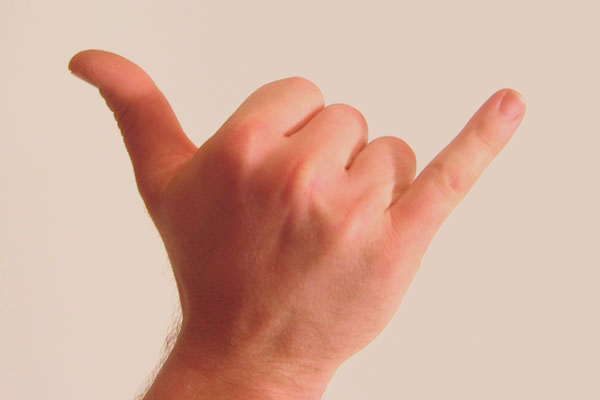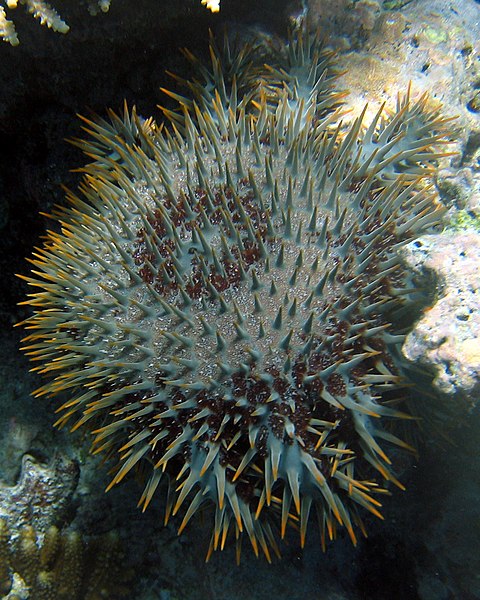We took our first trip off the Kona coast and went to check out the more rugged and rural north coast of the Big Island. A lot of the drive took us up the seemingly endless lava plain that makes up the northwest quarter of the island. It looks a lot like Iceland, except it’s sunnier and there’s more shrubbery. There aren’t any big flat surfaces for graffiti, so instead the Hawaiians write their roadside messages by arranging white coral on the black lava.
Once we got up off the coast, the landscape got greener, hillier and a lot more agricultural. We saw cows, sheep, horses, chickens, and even some goats. If not for the tropical plants and occasional sweeping ocean views, we could have been in Vermont.
We find the economics here to be mysterious. Hawaii is so expensive and isolated, how could you possibly make a living raising goats? Are all of these farms a source of amusement for rich transplants and retirees, or are they all just fronts for lucrative pot farming, or what?
I didn’t think to bring the cable that connects my phone to the car stereo, so as we do all this driving, we’re dependent on radio for entertainment. Hawaii is long on natural beauty but a little lacking in its musical culture. The radio is about 60% lite reggae, 25% lite pop and 15% Nashville country. Forget about hip-hop or anything edgy, there isn’t even a classic rock station. Thank god for NPR.
Our friend Katie lent us a book of hikes on the Big Island. The very first one it lists is the Waipio Valley. It’s a secluded spot between two almost vertical cliffs, with a little river snaking down to a black sand beach. The only way down is by a narrow single-lane road that you could almost rappel down. Here’s the view from the top.
The valley is inhabited by even crunchier hippies than the ones we met at the Kona farmer’s market. They have electricity down there, but that’s apparently a quite recent development. One of the “roads” is a six-inch-deep stream — we saw a grandmotherly white-haired lady nonchalantly drive her pickup truck up it. There seems to be some marginal tropical agriculture happening; again, how it all works financially is a mystery. It feels more like Jurassic Park than a farming community. Looming in the background is a pair of waterfalls plunging off the cliffside to feed the river. The trees are densely hung with vines, and there are colorful flowers of the kind that you see on Hawaiian shirts.
After we walked around the valley a little, we went out to the beach you see in the picture, which is truly epic. Not only does it have cliffs and god rays and the river winding through round porous volcanic rocks, but there are also horses roaming freely. I couldn’t tell if they’re wild or just have very laid-back owners. Anna observed that the only thing missing is rainbows and unicorns.
We dragged ourselves back up the cliffside road and drove up to the nearby Kalopa State Recreation Area to take in some more nature before it got dark. It’s a forest preserve with a lovingly maintained rainforest arboretum, and we basically had the place to ourselves. The park brochures are charmingly earnest and old-school, written on a typewriter. They’re dated 1992 but could easily have been written in 1952. There are trees with rainbow-colored bark and pink leaves, and prehistoric-looking ferns. The ground is littered with smashed guavas, making the place look like a tragic accident at the smoothie factory. We saw a lot of mongooses slinking around, and a couple of pheasants, descended from birds inexplicably imported from Nepal.
Before we left we stuffed our suitcases with bulk food and power bars from the Food Coop, and we’ve been cooking all of our meals since we got here. But after all the hiking we finally had our first dinner out, and it was a classy one, at Merriman’s in Waimea. The high-end locavore movement was late in arriving to Hawaii, but now it seems to have fully taken root, and Merriman’s is holding the banner high. We ate all kinds of local treats: pickled passionfruit, sauteed ferns, ahi, pork, lamb, and the most expensive and sensationally delicious cups of coffee of our lives. It was like boiled dark chocolate bars. In the movie of our trip, our waiter would be played by Johnny Depp in full manic mode. He had a Fu Manchu beard and his thumb and pinkie nails were painted a shiny turquoise. I asked him what the story was there and he explained without a trace of irony that it was to widen his shaka.
The tiki motif is getting old, but the music was nice, including a gorgeous lap steel instrumental version of “Wichita Lineman.” Way better than cheesy reggae.
The next day we got up bright and early to go on an organized snorkeling trip run by Sea Paradise in Kealakekua Bay, the site of the Captain Cook monument. We had wanted to hike down there, but development on the coast has made that difficult, and it turned out to be better to see it from the water anyway. Sea Paradise took us out in a catamaran, and I want to pause to enjoy that word. Catamaran. Catamaran! It’s fun just typing it.
We had a good couple of hours bobbing around the bay among the banyan trees and giant boulders, gawking at the psychedelic fish and coral. It’s like being in a screen saver. If you’re interested in how complex forms emerge and self-organize through natural selection, there’s no better place to see it in action than in the ocean around Hawaii. The patterning on the fish is a dazzling display of cellular automata and reaction-diffusion. Steven Wolfram would be in heaven.
The magic isn’t just that the fish are so colorful and groovy, or that there are so many of them. It’s that they’re mostly so unconcerned by human presence. A few fish avoided us but most went about their business as if we weren’t there. The needlefish especially were willing to hang in my face making prolonged eye contact.
The weirdest thing I saw all day was a crown-of-thorns starfish. It took me a while to figure out whether it’s an animal, a plant or a particularly weird coral shape. It’s a good foot wide at least.
It’s a depressingly recurring theme: spectacular exotic creature turns out to be invasive or in some way harmful to Hawaii’s delicate ecosystem. The crown-of-thorns starfish isn’t an invader, but it is a problem. It eats coral, putting more pressure on the already beleaguered reefs, and its natural predator, the conch, has been fished nearly into oblivion.
Snorkeling is fun but exhausting. Two hours of it plus a boat ride on other end completely wiped us out. We mostly spent the rest of the afternoon sleeping.







